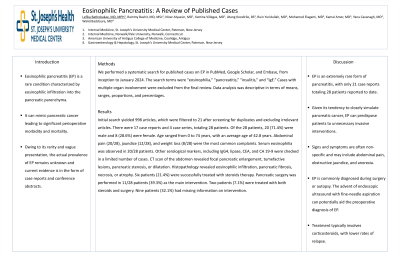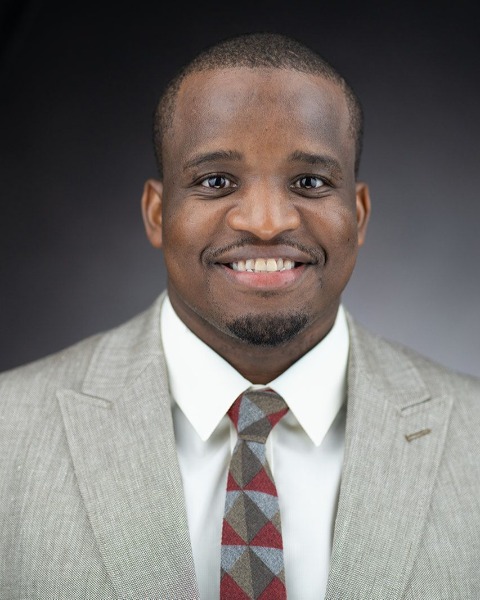Tuesday Poster Session
Category: Biliary/Pancreas
P3468 - Eosinophilic Pancreatitis: A Review of Published Cases
Tuesday, October 29, 2024
10:30 AM - 4:00 PM ET
Location: Exhibit Hall E

Has Audio

Lefika Bathobakae, MD
St. Joseph's University Medical Center
Paterson, NJ
Presenting Author(s)
Lefika Bathobakae, MD1, Rammy Bashir, MD2, Nizar Alyassin, MD3, Katrina Villegas, MD3, Atang Koodirile, BS4, Ruhin Yuridullah, MD3, Mohamed Elagami, MD3, Gabriel Melki, MD5, Kamal Amer, MD5, Yana Cavanagh, MD5, Walid Baddoura, MD5
1St. Joseph's University Medical Center, Paterson, NJ; 2St. George’s University School of Medicine, Grenada, West Indies, Paterson, NJ; 3St. Joseph’s University Medical Center, Paterson, NJ; 4American University of Antigua College of Medicine, Coolidge, Antigua, Paterson, NJ; 5St. Joseph's University Medical Center, Paterson, NJ
Introduction: Eosinophilic pancreatitis (EP) is a rare condition characterized by eosinophilic infiltration into the pancreatic parenchyma. It can mimic pancreatic cancer, leading to significant perioperative morbidity and mortality. Owing to its rarity and vague presentation, the actual prevalence of EP remains unknown, and current evidence is in the form of case reports and conference abstracts.
Methods: We performed a systematic search for published cases on EP in PubMed, Google Scholar, and Embase, from inception to January 2024. The search terms were “eosinophilia,” “pancreatitis,” “insulitis,” and “IgE.” Cases with multiple organ involvement were excluded from the final review. Data analysis was descriptive in terms of means, ranges, proportions, and percentages.
Results: The initial search yielded 998 articles, which were filtered to 21 after screening for duplicates and excluding irrelevant articles. There were 17 case reports and 4 case series, totaling 28 patients. Of the 28 patients, 20 (71.4%) were male and 8 (28.6%) were female. Age ranged from 0 to 74 years, with an average age of 42.8 years. Abdominal pain (20/28), jaundice (12/28), and weight loss (8/28) were the most common complaints. Serum eosinophilia was observed in 20/28 patients. Other serological markers, including IgG4, lipase, CEA, and CA 19-9, were checked in limited cases. CT scan of the abdomen revealed focal pancreatic enlargement, tumefactive lesions, pancreatic stenosis, or dilatation. Histopathology revealed eosinophilic infiltration, pancreatic fibrosis, necrosis, or atrophy. Six patients (21.4%) were successfully treated with steroid therapy. Pancreatic surgery was performed in 11/28 patients (39.3%) as the main intervention. Two patients (7.1%) were treated with both steroids and surgery. Nine patients (32.1%) had missing information on intervention.
Discussion: EP is an extremely rare form of pancreatitis, with only 21 case reports totaling 28 patients reported to date. Given its tendency to closely simulate pancreatic cancer, EP can predispose patients to unnecessary invasive interventions. Signs and symptoms are often non-specific and may include abdominal pain, obstructive jaundice, and anorexia. EP is commonly diagnosed during surgery or autopsy. The advent of endoscopic ultrasound with fine-needle aspiration can potentially aid the preoperative diagnosis of EP. Treatment typically involves corticosteroids, with lower rates of relapse.
Disclosures:
Lefika Bathobakae, MD1, Rammy Bashir, MD2, Nizar Alyassin, MD3, Katrina Villegas, MD3, Atang Koodirile, BS4, Ruhin Yuridullah, MD3, Mohamed Elagami, MD3, Gabriel Melki, MD5, Kamal Amer, MD5, Yana Cavanagh, MD5, Walid Baddoura, MD5. P3468 - Eosinophilic Pancreatitis: A Review of Published Cases, ACG 2024 Annual Scientific Meeting Abstracts. Philadelphia, PA: American College of Gastroenterology.
1St. Joseph's University Medical Center, Paterson, NJ; 2St. George’s University School of Medicine, Grenada, West Indies, Paterson, NJ; 3St. Joseph’s University Medical Center, Paterson, NJ; 4American University of Antigua College of Medicine, Coolidge, Antigua, Paterson, NJ; 5St. Joseph's University Medical Center, Paterson, NJ
Introduction: Eosinophilic pancreatitis (EP) is a rare condition characterized by eosinophilic infiltration into the pancreatic parenchyma. It can mimic pancreatic cancer, leading to significant perioperative morbidity and mortality. Owing to its rarity and vague presentation, the actual prevalence of EP remains unknown, and current evidence is in the form of case reports and conference abstracts.
Methods: We performed a systematic search for published cases on EP in PubMed, Google Scholar, and Embase, from inception to January 2024. The search terms were “eosinophilia,” “pancreatitis,” “insulitis,” and “IgE.” Cases with multiple organ involvement were excluded from the final review. Data analysis was descriptive in terms of means, ranges, proportions, and percentages.
Results: The initial search yielded 998 articles, which were filtered to 21 after screening for duplicates and excluding irrelevant articles. There were 17 case reports and 4 case series, totaling 28 patients. Of the 28 patients, 20 (71.4%) were male and 8 (28.6%) were female. Age ranged from 0 to 74 years, with an average age of 42.8 years. Abdominal pain (20/28), jaundice (12/28), and weight loss (8/28) were the most common complaints. Serum eosinophilia was observed in 20/28 patients. Other serological markers, including IgG4, lipase, CEA, and CA 19-9, were checked in limited cases. CT scan of the abdomen revealed focal pancreatic enlargement, tumefactive lesions, pancreatic stenosis, or dilatation. Histopathology revealed eosinophilic infiltration, pancreatic fibrosis, necrosis, or atrophy. Six patients (21.4%) were successfully treated with steroid therapy. Pancreatic surgery was performed in 11/28 patients (39.3%) as the main intervention. Two patients (7.1%) were treated with both steroids and surgery. Nine patients (32.1%) had missing information on intervention.
Discussion: EP is an extremely rare form of pancreatitis, with only 21 case reports totaling 28 patients reported to date. Given its tendency to closely simulate pancreatic cancer, EP can predispose patients to unnecessary invasive interventions. Signs and symptoms are often non-specific and may include abdominal pain, obstructive jaundice, and anorexia. EP is commonly diagnosed during surgery or autopsy. The advent of endoscopic ultrasound with fine-needle aspiration can potentially aid the preoperative diagnosis of EP. Treatment typically involves corticosteroids, with lower rates of relapse.
Disclosures:
Lefika Bathobakae indicated no relevant financial relationships.
Rammy Bashir indicated no relevant financial relationships.
Nizar Alyassin indicated no relevant financial relationships.
Katrina Villegas indicated no relevant financial relationships.
Atang Koodirile indicated no relevant financial relationships.
Ruhin Yuridullah indicated no relevant financial relationships.
Mohamed Elagami indicated no relevant financial relationships.
Gabriel Melki indicated no relevant financial relationships.
Kamal Amer indicated no relevant financial relationships.
Yana Cavanagh indicated no relevant financial relationships.
Walid Baddoura indicated no relevant financial relationships.
Lefika Bathobakae, MD1, Rammy Bashir, MD2, Nizar Alyassin, MD3, Katrina Villegas, MD3, Atang Koodirile, BS4, Ruhin Yuridullah, MD3, Mohamed Elagami, MD3, Gabriel Melki, MD5, Kamal Amer, MD5, Yana Cavanagh, MD5, Walid Baddoura, MD5. P3468 - Eosinophilic Pancreatitis: A Review of Published Cases, ACG 2024 Annual Scientific Meeting Abstracts. Philadelphia, PA: American College of Gastroenterology.
